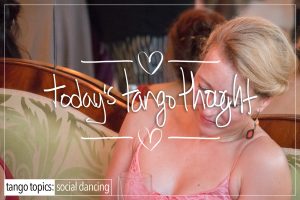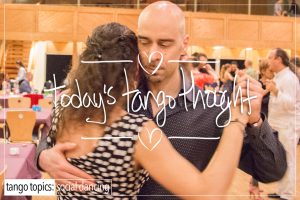If you’ve been dancing a little while, or for many years, at some point along the curve you’ve heard the word ‘Cabeceo’. Which roughly translates as a slight nod or nodding of the head (Cabeza) for the Lead to invite a Follower. The Follower’s side of that same invitation is referred to as a ‘Mirada’ (to look at, or ‘looked’). It’s an oddity that almost no one knows about the Follower’s side of the equation, that the Follower can ask for a tanda, employing the same methodology. It just has a slightly different name. Only in the case of a Follower’s askance, the Follower does NOT get up and walk around the room to their intended party! They stay in place until their Lead comes to collect them! Otherwise we end up with another problem: The Wrong Partner Problem!
However, a good number of dancers, for a variety of reasons, ignore these things in Tango. Some because they don’t know any better (yet)…ignorance, and they need to be edumacated. Some don’t use it because they do (ahem)! The action/process of Cabeceo/Mirada exists for a reason (several actually). One of the hallmarks of the action of Cabeceo/Mirada requires that there be a good 30 meters between you when you employ the method. The further away, the better, within reason and line of sight. If nothing else Argentines are an entirely ‘practical’ people in certain places, sometimes wholly irrational about some things, and others entirely practical. This is one of those things where they’re very practical: Why get up and walk across the room, when it’s 10 times easier to stare at someone from across the room with the same intent ? Get enough people doing this, and doing it over a period of time, and you’ve got yourself a movement towards ‘codigos’ (codes of the dance).
Today’s reminder about Cabeceo/Mirada deals with a piece of the situation where the Lead or the Follower that sits down next to someone and then talks their ear off hoping to invite them for a dance. This is very similar to the action of “Chataseo” but with a slightly different perspective. In the case of “Chataseo”, either role is talking their intended partner up for a tanda without mentioning that they’d like to dance, usually before the next tanda starts. The difference is that these partners generally know one another, and have danced together before and have a knowledge of each other. Whereas in the case of the ‘Talking Cabeceo”, generally these partners aren’t that familiar with each other.
This Cabeceo/Mirada issue arises when a verbal request for a dance has been refused, and then instead of going away, the verbal asker (tsk, tsk, tsk), decides to sit down and engage in polite conversation for whatever reason. This sends a message to the room that the askee (the person that refused) is in an awkward position now and must talk to someone that they may or may not want to talk to (especially having just turned down a dance). So if there were other interested parties, then those potential partners will not ask to dance because it would be rude to do so, and/or because they witnessed someone else being turned down and now they’re talking to someone. Sounds complicated ? It’s not. It’s called being polite.
Really the best practice is to employ Cabeceo at a distance, and when you’ve been refused move on. If you’ve been accepted, proceed with the dancing part.











